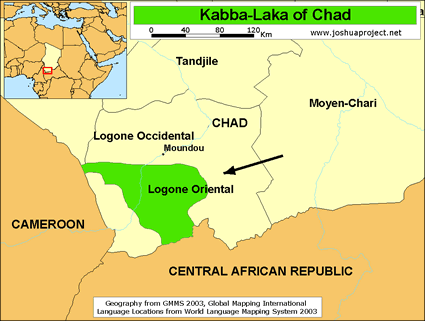

The Laka (Laus, Lao Habes) are a subgroup of the Ngambaye people, who were once a large and powerful ethnic group in northern Cameroon, southern Chad, western Central African Republic, and northern D.R.Congo. Some can also be found in Borno State in Nigeria.
Most Laka live in villages where little notice is taken of events outside their own region. Even through the Laka can understand their populous neighbors, the Ngambay, they are a separate ethnic group with their own traditions and history. The Laka area is an area of Chad that is known for agriculture, and many Laka plant cotton for cash crops in addition to millet which is for making their staple 'boule ', which is a half round ball of millet cooked into a thick paste which is dipped in a sauce. They also grow corn, manioc and other vegetables, along with beef cattle.

For centuries, with the linguistically related Mbuns, they dominated the Adamawa región, battling periodically against Fulbe slave raiders. Those slave raids continued into the early twentieth century.
It is believed that Laka peoples originated from the northwest in the area near Lake Chad and were pushed southward over the last two centuries by the expansion of the Fulani empire into their current location in southern Chad. They share linguistic and cultural ties with their Cameroonian neighbors who live to the south and were also pushed south by the Fulani.
During the late nineteenth and early twentieth centuries, the Lakas fiercely resisted German and French colonization efforts, suffering military defeat and population decline in the process. They are a Bantu people. In D.R. Congo, the Lakas strongly supported the Kwilu Rebellion in the mid 1960s. Still suspicious of the central government of Zaire, they live as small farmers.
Cotton is the primary crop grown for export. Millet and peanuts are also staples. Most Laka are sedentary farmers who plant seasonal crops during the rainy season, which extends from April to October.
Most villages are organized around a patrilineage. Leadership is accorded to those elders in the village who are able to trace their descent from the first Laka lineage to occupy the village. Other lineages may live in a village, but the descendents of the first lineage usually retain a paramount status. As such, they are responsible for heading initiation instruction and making most important agricultural decisions. A council of elders with representatives from each lineage work together to govern a village.
Laka religion centers around recognition of the ancestors. Ownership of land is directly tied to the founding ancestors' remains being buried on that land. Offerings are made to the ancestors daily in the form of libations and food offerings.
Sources: